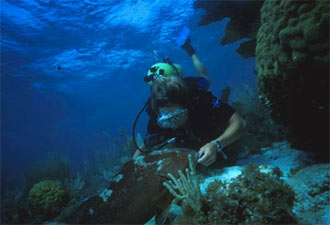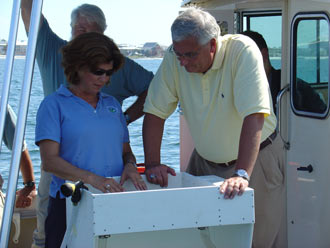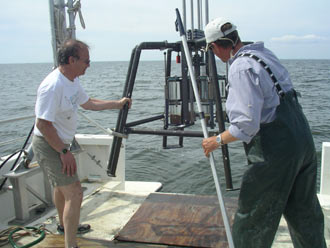
 |
|
||
On this page ...
- Preventing Pollution Before It Happens
- Assessing the Health of Our Coral Ecosystem
- EPA Dive Team Program
- Endocrine Disrupting Chemicals (EDC) Research
- Studying Organisms and Estuaries
- Examining Oxygen Depleted Zones in the Gulf
- Bay Scallop Habitat Assessment Models
Preventing Pollution Before It HappensTom Murray | EPA Senior Biologist

Tom Murray
Have you ever asked the question: “Why not prevent pollution before it becomes a difficult-to-control reality”? Well, an energetic collection of EPA scientists, economists and entrepreneurial thinkers have been addressing this question since the late 1980s. Through Congressional action to pass the Pollution Prevention Act of 1990 and fueled by several Presidential Executive Orders, this small group of individuals nested primarily within the Office of Prevention, Pesticides and Toxic Substances and the Regions, has methodically taken the pollution prevention message from the imagination to the corporate boardroom. Who would have imagined back in the 1970s that today we would be working in partnership with major corporations to consider the environment in the design of their products? Who would have imagined that we would be teaching the principles of environmental accounting and green chemistry and engineering in our universities and that environmentally-preferable purchasing would become a routine practice? Who could envision that in the 21st century we would witness a sea change in corporate policies from one of profitability to one of sustainability or green profitability and that the buildings these corporations occupy and the meetings they conduct would be built upon environmental principles?
From a professional who has spent his entire career in public service protecting the environment, words cannot adequately express the satisfaction of watching major corporations embrace the principles of pollution prevention as a central tenet of the business case, assuming responsibility not only at the corporate level but also throughout the supply chain. Today, companies are viewing EPA not only as a regulator, which it always must be, but also as a source for valuable information, peer-reviewed tools and good old-fashion know-how. Companies are working in partnership with EPA to eliminate the use of toxic chemicals and reduce waste while increasing efficiency. Moreover, they are finding ways to convert by-products into marketable commodities. And the beauty of it all is that they are able to do so while achieving significant cost savings up and down the supply chain. A win for everyone!
Tom Murray is chief of the Prevention Analysis Branch in the Pollution Prevention Division
of the Office of Prevention, Pesticides and Toxic Substances.
![]() Learn more about pollution prevention
Learn more about pollution prevention
Assessing the Health of Our Coral Ecosystem
Becky Hemmer | EPA Marine Biologist
Coral reefs cover many square miles of the earth’s ocean floor. But in recent decades, the reefs have been showing worldwide declines in health and productivity. Increasing sea water temperature, combined with human pollution and population growth in coastal zones threaten to further weaken this fragile ecosystem.

Becky collects data from a coral reef off the coast of the U.S. Virgin Islands while a small grouper observes her work.
Scientists at EPA’s Gulf Ecology Division (GED) have developed new, rapid underwater techniques for assessing the health and condition of coral reefs. The techniques combine two traditional approaches for measuring stony corals, the hard corals that are building blocks of the reef. These methods are being used to determine what factors are causing the coral population to dwindle and the appropriate action to take to protect this important natural resource. Stony corals form the structural foundation of the reef. They are colonies of small animals, called polyps that grow and use energy from symbiotic algae to build a hard calcium carbonate (limestone) skeleton. As the coral colonies grow, so do their skeletons, which form the hard structure of the reef. It is this hard structure that provides vital shoreline protection and habitat for abundant and diverse marine life.
The coral reef assessment project is only part of a comprehensive coral research effort at GED. Innovative laboratory exposure systems are also used to investigate the responses of stony corals and their symbiotic algae to a variety of stresses. One of the greatest stresses to coral reefs is sediment that escapes downstream from land development and collects in the coastal zone. This sediment not only blocks sunlight from the photosynthetic algae that corals rely on, but forms a layer over the coral

Becky uses EPA’s new rapid underwater techniques to assess the condition of a reef.
polyps that interferes with feeding and metabolism. Nutrients, pesticides, bacteria and viruses released into rivers and streams can also reach coral reefs and have damaging effects. Research at GED is directly aimed at defining the limits of pollution that stony corals can withstand. The information can then be incorporated into the water quality standards in jurisdictions such as the Virgin Islands. It is a primary responsibility of the U.S. EPA to assist states, tribes and territories in providing clean, clear water for human use and biological integrity.
Becky Hemmer is a marine biologist within EPA’s Gulf Ecology Division at the National Health and Environmental Effects Research Laboratory.
![]() Learn more about our coral ecosystem
Learn more about our coral ecosystem
EPA Dive Team Program
Jed Campbell | EPA Dive Instructor

Student divers prepare for a dive during the EPA Diver Training Program. Jed Campbell (right center with sunglasses) organizes and leads the training course.
EPA relies on many techniques to support our ocean and coastal protection programs. Scuba divers remain an important part of the team responsible for keeping our water clean and safe. Each year, a handful of EPA’s regional and program office staff attend an intensive one-week training program and certification with the hope of becoming EPA’s newest class of divers.
What makes EPA’s dive teams unique? In addition to certifications including Scientific Diver, Divemaster and other advanced ratings, EPA divers learn to dive in polluted, and often hazardous, conditions. Divers provide scientific polluted water diving services through inspections, sampling, surveys and long-term monitoring. The dive teams are also equipped with special equipment such as underwater cameras to document their findings, underwater mapping devices, sophisticated ocean diver communications and have access to remote operated vehicles (ROV). These tools aid the dive teams as the support EPA programs, for example: Superfund, Clean Water Act work and partnerships with other federal agencies and state governments.
In 2006, the Diver Training Program was awarded an Agency bronze medal for“developing and conducting an exemplary Diver Training Program that certified over 500 divers who recorded over 30,000 dives with no serious injuries.”
Jed Campbell is a Dive Instructor within EPA’s Gulf Ecology Division at the National Health and Environmental Effects Research Laboratory.
![]() Learn more about the EPA dive team program
Learn more about the EPA dive team program
Endocrine Disrupting Chemicals (EDC) Research
Dr. Sandy Raimondo | EPA Scientist

Dr. Sandy Raimondo multi-tasks while developing a computer model for detemining how EDCs can effect populations of aquatic animals.
Due to the potential global scope of Endocrine Disrupting Chemicals (EDC), the possibility of serious problems in humans and wildlife they pose and the persistence of some suspected EDCs in the environment, research on EDCs is a high priority at EPA. The Gulf Ecology Division is conducting research to investigate sources of suspected EDCs that impact the environment and the risks EDCs pose to the long-term abundance and viability of fish and wildlife species. Mathematical computer modeling is an essential tool for ecological research.
EDCs enter the environment from municipal, agricultural, and industrial wastewaters. These chemicals, which can mimic natural reproductive and metabolic hormones, can cause impaired reproduction, survival, and development in fish and other aquatic animals exposed to them. Population models employ data from field and laboratory studies, along with sets of equations, to investigate risks to the long-term abundance and viability of fish and wildlife species. The goal of these models is to minimize the exposure of humans and wildlife to suspected EDCs.
Dr. Sandy Raimondo is a scientist within EPA’s Gulf Ecology Division at the National Health and Environmental Effects Research Laboratory.
Studying Organisms and Estuaries
Virginia Engle | EPA Ecologist

Virginia Engle explains the “benthic index” to EPA Administrator Stephen Johnson.
The National Coastal Assessment is a partnership between EPA, coastal states and other Federal agencies which completed assessments of all U.S. estuaries during 2000-2007 to survey the condition of our nation's coastal resources. This partnership was formed due to the need for nationally comparable data to determine the condition of our nation’s ecosystems. Types of data include water column parameters, sediment chemistry and toxicity, benthic communities, demersal fish and tissue contaminants. Two National Coastal Condition reports have been published, and a third report is scheduled for publication in 2008.
One study included in National Coastal Assessment in 2007 was the “benthic index.” Benthic organisms are small animals (such as clams and crustaceans) that live in or on the bottom sediments in water bodies. Because they don’t move very far, if at all, during their life spans, they are good indicators of the environmental conditions in the area from which they were collected.
Low diversity and abundance of organisms like the benthic organism, or prevalence of pollution-tolerant species, can indicate the conditions in the water are poor. The design of the NCA program is probabilistic, which means that it can be used to estimate what percentage of the nation's waters are in good, fair or poor condition.
Virginia Engle is an ecologist within EPA’s Gulf Ecology Division at the National Health and Environmental Effects Research Laboratory.
![]() Learn more about The National Coastal Assessment
Learn more about The National Coastal Assessment
Examining Oxygen Depleted Zones in the Gulf
Dr. Pete Eldridge | EPA Ecologist

EPA’s Dr. Pete Eldridge and biologist Bob Quarles use a multi-core sampler to retrieve core sediment from the Gulf of Mexico.
The Mississippi River Basin is the largest watershed in North America, draining 41% of the continental United States and discharging into the Northern Gulf of Mexico. Aquatic ecosystems, and national and local economies, depend on healthy, oxygen-rich Gulf waters, which can be negatively impacted by excess nutrients (eutrophication). In 1997, a coalition of federal, state, and tribal agencies established the Mississippi River/Gulf of Mexico Watershed Nutrient Task Force to understand the causes and effects of eutrophication in the Gulf of Mexico and to coordinate activities to help reduce the area of oxygen-depleted water in the Gulf, also known as the hypoxic zone.
Hypoxia means an absence of oxygen reaching living tissues. In coastal waters, it is characterized by low levels of dissolved oxygen, so that not enough oxygen is available to support fish and other aquatic species. Each year, an area of the Gulf of Mexico becomes devoid of fish and other aquatic life. The phenomenon is a result of oxygen-depleted water. Now commonly referred as the “dead zone,” it is one of the largest in the world. It occurs off the Louisiana shore westward from the mouth of the Mississippi River, and in some years, can extend as far as the Texas coast.
Since 2002, EPA’s Gulf Ecology Division has been conducting seasonal cruises with intensive sampling throughout the hypoxic zone. Core samples are studied to determine how rapidly oxygen is depleted in the overlying water, and how oxygen depletion is associated with sediment and water chemistry.
Balancing the demands of navigation, agriculture, recreation, industry, and wildlife is not easy. However, a number of collaborative partnerships are fostering a better understanding of this dynamic ecosystem, and coordinated actions are under way to address some of its most pressing challenges.
Dr. Pete Eldridge is an ecologist within EPA’s Western Ecology Division at the National Health and Environmental Effects Research Laboratory.
![]() Learn more about the Mississippi River Basin
Learn more about the Mississippi River Basin
Bay Scallop Habitat Assessment Models
Marty Chintala | EPA Scientist

EPA scientist Eric Weissberger (left) collects bay scallops as part of a habitat survey in Lagoon Pond on Martha’s Vineyard, Massachusetts.
Traditionally, the bay scallop (Argopecten irradians) has played an important role in the culture and economy of the East Coast. Scallops were particularly abundant from Southern Massachusetts to Great South Bay on Long Island, New York. A decade ago, dockside value for scallop harvests was $1.8 million dollars in Long Island.
In recent years, however, the availability of bay scallops has greatly diminished. By the mid 1980s, the scallop fishery in states like Rhode Island had ceased all-together. Many reasons have been given for this decline, including poor water quality (the result of low oxygen or elevated nutrients), habitat degradation (such as eelgrass depletion), predation (species such as crabs and starfish) and harmful algal blooms (such as brown tides).
NHEERL’s Atlantic Ecology Division is actively

Weissberger and EPA’s Alana Hanson remove a line of tethered bay scallops from Ninigret Pond, Rhode Island, at the end of an experiment to determine the predation rates for bay scallops.
researching the scallop-habitat relationship. The aim of this study is to develop methods for predicting biological effects of habitat alteration and determining how populations of fish, shellfish, and aquatic dependent wildlife respond to habitat alteration.
Put simply, we’re trying to figure out how we can use our knowledge of scallop-habitat relationships to guide habitat-based criteria development and inform and evaluate bay scallop restoration efforts.
Field surveys, in conjunction with scallop restoration projects, are currently underway in Martha's Vineyard, Massachusetts, Nantucket, Massachusetts and Peconic Bay, New York. With the help of our newly acquired autonomous underwater vehicle, the Remus 100, we will be
mapping the habitats in the Massachusetts

EPA’s Giancarlo Cicchetti and Region 1’s Jean Brochi retrieve the Remus 100 after a sampling run.
ponds where our field surveys are being conducted.
Marty Chintala is a scientist within EPA’s Atlantic Ecology Division at the National Health and Environmental Effects Research Laboratory.